There’s no doubt the internet has become undeniably woven into the very fabric of our lives.
The internet informs our decisions, answers our questions, and expedites our work. It sends rockets to new worlds, seeks out new cures, and gives a voice to the voiceless. It plans our routes and ignites our love lives. Lets us check out our ex’s new partner and our second cousin’s wedding photos alike… all while providing the soundtrack to our lives and too many distractions from living them to the full.
With its all-encompassing reach, the internet is something we’ve all begun to take for granted. A new generation of online natives has emerged — and as anybody with kids will attest — the natural affinity the young have with the internet is equally impressive, bewildering, and frightening.
Indeed, in 2022, internet access is poised to become the newest recognized human right, giving it equal standing with access to water, shelter, and personal freedoms.
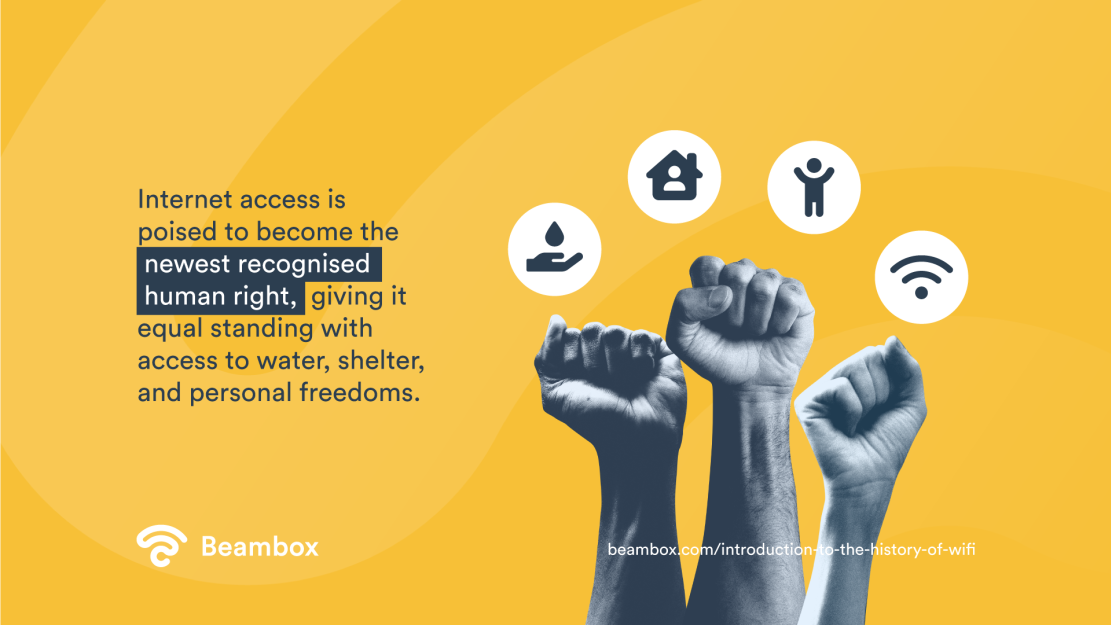
However, those of us of a certain age remember when it wasn’t all so seamless and easy. Pre-WiFi — back in the dark ages of grinding, growling dial-up tones, and arguing with your sibling over who’s using the telephone line — we would never have imagined the speed and ease at which the web could be accessed.
So, how did this new age of ultra-fast, far-reaching and civilisation-defining WiFi come about? Well, that’s exactly what we’re about to dive into. Let’s talk about the invention of WiFi as we know it.
The Unexpected Roots of WiFi
You’d be forgiven for assuming that WiFi, in at least its earliest forms, began its digital life somewhere in a research lab beneath the streets of London, home to enigma machines and the early internet experiments of Sir Tim Berners-Lee, or in a Soviet-era spy control center, or even beneath the deserts of Silicon Valley.
However, not only do the origins of WiFi pre-date the arrival of the World Wide Web in 1989, it was born amid the tropical climes of Hawaii, where academics were tirelessly toiling away with pioneering technologies (presumably between sipping Mai Tais and catching waves).
It’s true - way back in 1971, the University of Hawaii completed something entirely new, which they almost certainly didn’t envision as an innovation that would change the entire world as we know it. By creating the very first wireless data packet transfer - a technique for sharing information completely free from connecting cables or satellite transmissions - the small team was able to communicate across seven Hawaiian islands in a way never achieved before.
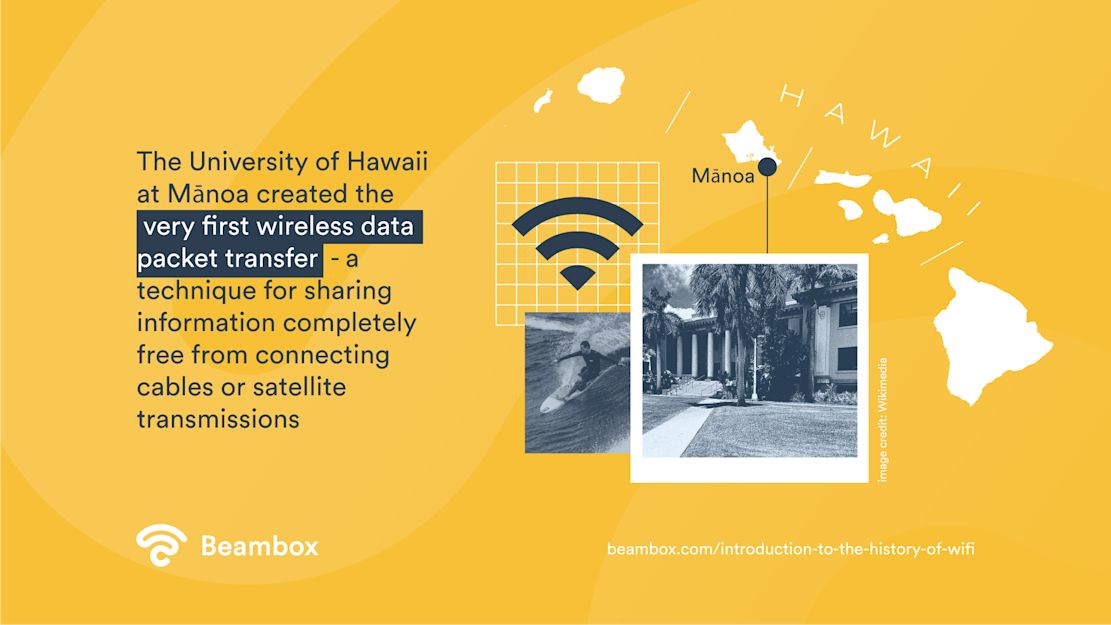
The project was called ALOHANET, taking the native word for ‘hello’ and creating a new piece of vocabulary in ways familiar to anybody who’s ever quickly had to make up a new Twitter handle.
Invented by a small team led by Norman Abramson, a computer scientist and engineer who surely deserves to be a household name, ALOHANET made use of a brand new piece of technology: Ultra High-Frequency radio waves, or UHF for short. Adapting a similar type of wave previously used primarily in television broadcasting.
By utilizing UHF, the team was able to wirelessly connect seven computers - each on an island separated by mile upon mile of the sea - and share data between them in ways startlingly similar to what happens whenever you click ‘send’ on an email.
Wireless Networks Through the Eighties
What happened next? Well, not an awful lot for the next decade or so.
The fact of the matter is that this technological leap was almost too great to be fully understood, and a lack of context or imaginable practical uses (beyond sharing small pieces of data between gargantuan computers on Hawaiian islands) meant that it was seen as little more than a stepping stone towards something greater… and that ‘something’ was yet to be envisioned.
The other issue back in 1971 was one of red tape. At the time of those early ALOHANET experiments, almost all telecommunications channels were regulated by the government - a situation which was, back then, made all the more potent and paranoid by the tension of the Cold War.
However, 1985 saw perhaps the next significant leap forwards in the creation of the WiFi we know and love today. The Federal Communications Commission opened three distinct bands of telecommunications for completely unlicensed use - a move that was mirrored in several developed countries elsewhere in the world.
This meant that suddenly, individuals, companies, organizations, and entrepreneurs were able to communicate via unregulated local area networks and wireless communications routes.
Computers began joining other computers to enjoy the freedom of unlicensed instant messaging, and IBM, AT&T, and NCR (among others) began developing relatively complex networks of their own, demonstrating how wireless connections were unquestionably good for business.
With the microchip revolution underway, and the pace of developments gearing up for breakneck speed, these early networks weren’t just useful business tools or ways to seamlessly set up and close deals - they were the precursor for the WiFi we all use today.
New Millennium, New Innovations
For the vast majority of us, it was in the early 2000s that the word ‘WiFi’ started appearing on people’s lips. Up until then, we’d all been excitedly grappling with achingly slow download speeds, venturing into clunky chat rooms, and exploring the joys of instant messaging services after rushing home from school.
Indeed, despite the various roots and origins we’ve already covered, it’s more than fair to say that WiFi is an innovation of the millennium and one which shaped the optimism and technological leap that the year 2000 brought with it.
That primarily comes down to the work of Vic Hayes, known to some as the ‘father of WiFi’. Developing Wi-Fi was a group effort that Hayes oversaw as chairman of the Institute of Electrical & Electronics Engineers (IEEE). In 1999 Hayes introduced a brand new concept into the world of wireless networking, an international standard set for globe-crossing success, which he snappily named the IEEE 802.11 standard.
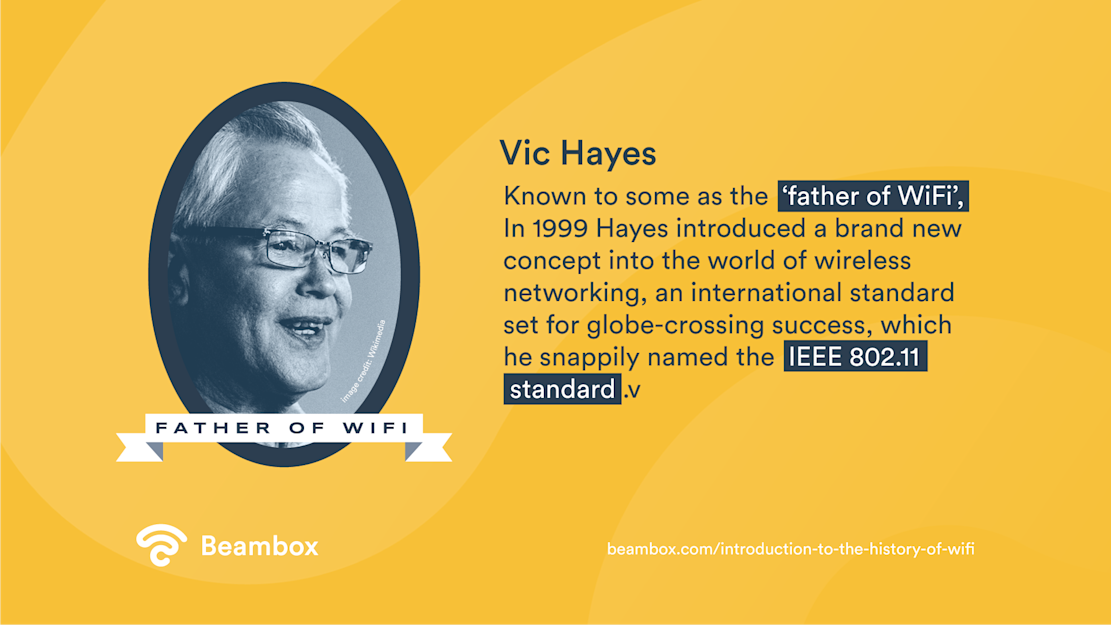
With a moniker like that, it’s no real surprise that a new name was needed once things started taking off. The IEEE isn’t best known for its branding experience, so it brought in an outside firm to come up with something that would roll off the tongue, and after considering ‘Hornet’, ‘Dragonfly’ and ‘Trapeze’, WiFi was the one to stick. But what is the definition of WiFi? The term Wi-Fi doesn’t stand for wireless fidelity or anything else. The marketing firm liked how it was similar to the term ‘Hi-Fi’ or high fidelity. So now you know the WiFi definition is not an acronym. WiFi is networking technology that uses radio waves to allow high-speed data transfer over short distances.
Hayes’ new standardized networking opened the floodgates of possibility, allowing for bigger, bolder, and more intricate networks without the need for tangles of cables… or the infamous dial-up tone, that those of us old enough to remember still occasionally hear in our dreams.
With this game-changing approach in place, it wasn’t long before global standards were set in place. The Wi-Fi Alliance was established later the same year, ensuring wireless internet access was primed to become the norm everywhere from Nantucket to Timbuktu.

Faster, Faster, Faster!
The five years following the turn of the new millennium saw internet-connected devices fly from the shelves. 100 million units of various types were sold year on year, showcasing that consumers across the planet were increasingly reliant on their WiFi network in their daily lives.
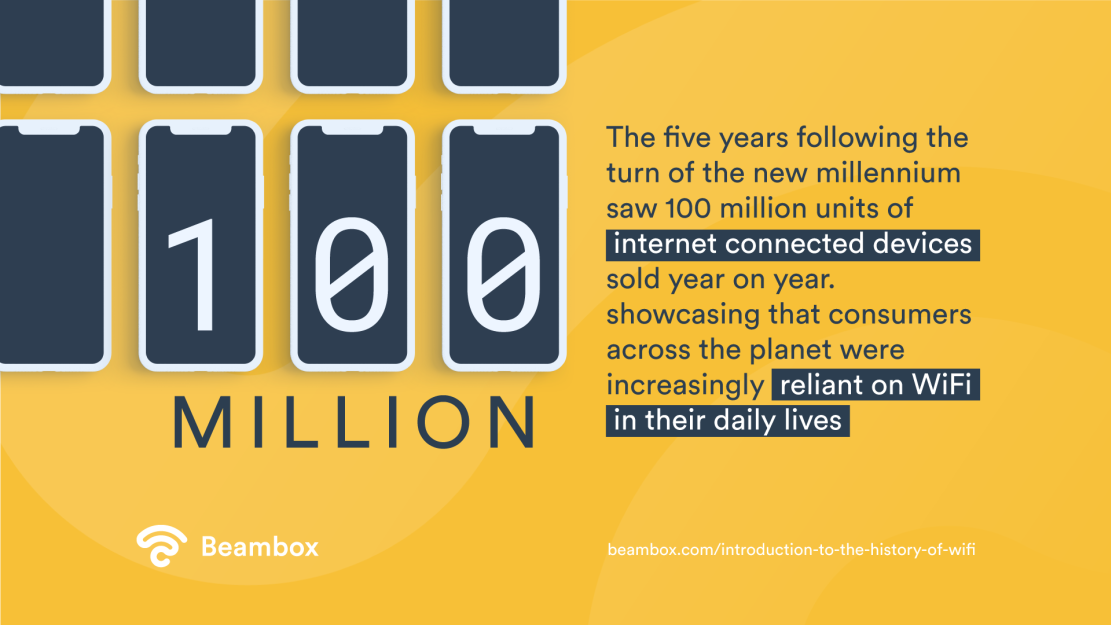
The blistering pace and increasing demand for smoother and faster connectivity required a response from the innovators behind the scenes. In 2014, the first big upgrade occurred. The original 802.11 standard pioneered by Hayes was levelled up to 802.11ac. This cleared the path for more rapid speed and greater coverage, satisfying those whose reception had been spotty and those who required faster services.
Since then, even greater speeds and services have been implemented, as consumers’ demands for faster and better WiFi have not abated with each year and with each new upgrade. Prompting questions, such as, “what’s the difference between 2.4 GHz and 5 GHz WiFi” and “how do you get free WiFi anywhere you go?” The simple fact of the matter is that today in 2022, we live in a world in which superfast WiFi has become normalized. Service providers are under incredible pressure from all corners to take speed and quality to previously unimaginable heights.
For example, marketers have long since discovered that consumers’ attention spans are becoming shorter when it comes to waiting for web pages to load. Any longer than a two-second wait will prompt the user to click the ‘back’ button and select another site… as such, breakneck speeds for both website owners and internet users have created a new battleground of consumer competition.
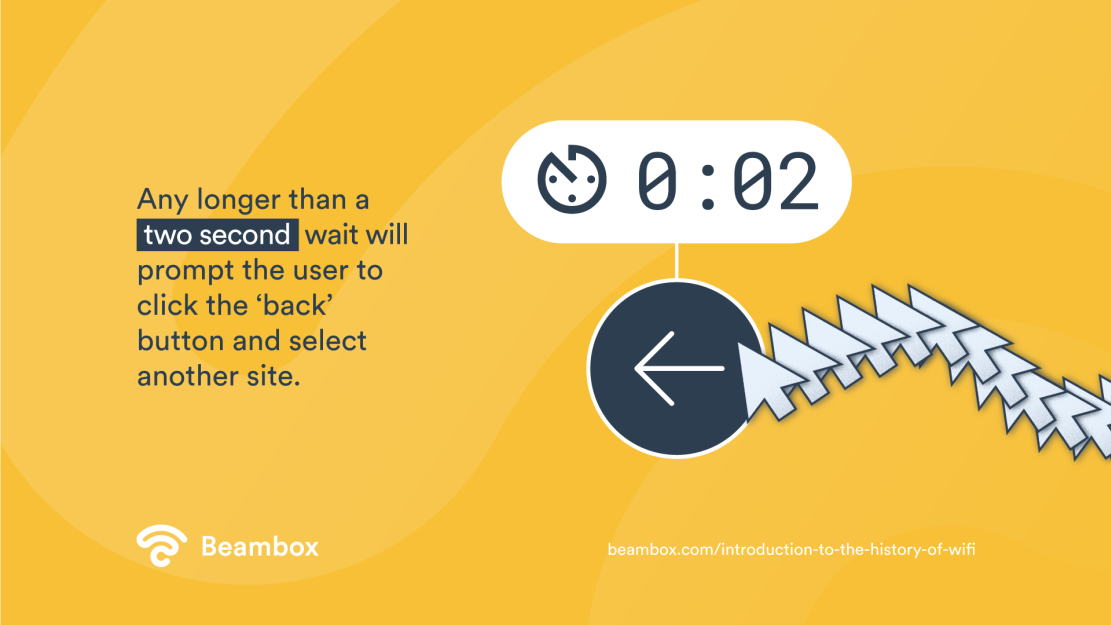
Speed, it seems, is the number one selling point for WiFi, as our lives get increasingly busier and the pressure mounts, it will be fascinating to see just where this trend peaks.
What’s Next for WiFi?
Faster. Stronger. Cleaner. Greener. Wireless technology continues to accelerate in its various transformations, reflecting the ways our lives have been altered by its presence, and by the awe-inspiring reality of billions of people being connected in every country on Earth. Customers look for the best review websites for small businesses and the businesses themselves search for ways to get more Google reviews as effectively as possible.
The future of WiFi is a secure one - now that the internet age has arisen it’s not going anywhere anytime soon. However, the way in which WiFi will affect the way we live, do our business and make the most of this complex and interconnected world is continuing to evolve beyond anything those early pioneers would have imagined possible.
What are the next big trends for WiFi? Let’s take a closer look at three which are not only primed and ready to change the future, but have already begun to transform the here and now.
The Internet of Things
It’s been a fair few years now since ‘The Internet of Things’ or IoT has become common parlance. However, all eyes are on the exciting array of developments that sit under this broad umbrella term. The IoT is set to become one of the most definitive technological paradigms of the next decade.
Across the past few decades, WiFi has moved from the massive, bulky computers of yesteryear to all kinds of slimline devices, including laptops, smartphones, tablets, and smartwatches.
However, it has also moved out of these realms and into our homes and cities, too. Wearable tech, smart devices installed into fridges, printers, cars, and doors, integrated home assistants and security systems… the list goes on and on. With ‘smart cities’ dubbed as the next new normal, the IoT is an ideology that will link up everyone and everything, improving the ease with which we work, play, and live our lives.
At its center? Wi-Fi.
With the bandwidth and adaptability to provide seamless connectivity, WiFi will link up citywide and nationwide networks to our homes, our cars, schools, workplaces, and beyond, as well as those of others elsewhere across the globe.
WiFi with Even Greater Reach
It’s no surprise to discover that the biggest developments in the WiFi of the future will be increased browsing speed and a considerably greater reach. With speeds skyrocketing and still struggling to meet demand, there is no shortage of blue-sky thinking going on, seeking out ways to take things to even greater heights.
One of the keys to reaching new levels of efficiency is by handling online congestion - digital traffic jams which slow down connectivity. This will require opening up new spectrums for data transference; something which is very much underway in order to cope with the rise of AI technology, increased automation, and the IoT becoming increasingly commonplace.
It’s far from unimaginable that technology will accelerate beyond the capabilities of the WiFi needed to underpin it. When this happens, we’ll need to look for even more radical approaches, and whole new ways to keep businesses, individuals, and whole continents connected.
Greater Privacy and Personalization
We all want greater levels of personalization in our lives, and no matter which direction technology bends, we still all crave to be treated as valued individuals - whether it’s at our favorite restaurant or bar, in the workplace, or while shopping for consumer goods.
AI and machine learning are unlocking new ways of personalizing our online experience, both through familiar methods like targeted advertising. Companies are now looking into social WiFi hotspots to grow business and utilize WiFi marketing to their advantage.
With so many of us inviting AI-enabled WiFi devices into our homes in the form of home assistants, these devices are keeping a (digital) eye on our movements and daily routines. It’s in the interest of businesses of all stripes and colors to hone their marketing to suit the specifics of your personality. With the known history of online shopping we can all expect to be mined for data simply by being connected to WiFi as we go about our daily lives.
Is there likely to be resistance to this? Almost certainly. Data privacy is very much a hot topic, with many asking, how can I see WiFi history? Browser histories and Google searches are being used to solve unlawful acts and perpetuate them. With cybercrime on the increase day by day, we’re all justifiably more wary of where our data is going. Time will tell just how far WiFi will intrude on our existence, and thank goodness there are tools to make your WiFi connection considerably safer already easily within reach!
Where Would We Be Without WiFi?
Well, most of us can remember life before WiFi, and we all managed pretty well in its absence. However, the evolution of technology is one which only marches forwards - and while many of us might love the idea of going ‘off grid’ for a while, few of us would find our lives improved by removing WiFi from our day to day existence.
The simple fact is, we love WiFi. With companies beginning to ask, what is WiFi marketing, they are getting on the free WiFi bandwagon too. We love visiting businesses with a good WiFi connection, we love the freedom to work and study on the go, and we love the ease it has brought to our lives. We may only be able to guess at what the future will bring, but one thing is for sure: the age of WiFi and the possibilities it has given rise to is only the beginning.
Businesses are looking into guest WiFi management software and how to set up guest WiFi solutions for the best WiFi systems available. If you are a business owner asking these questions, or wanting to learn how to increase revenues with WiFi sales, we recommend looking into all-in-one WiFi marketing solutions, like Beambox. Over 12,000 venues are taking advantage of Beambox to grow their business with guest WiFi, do you want to be next? Start your thirty-day free trial and turn your free WiFi into a machine for growth.